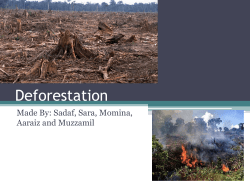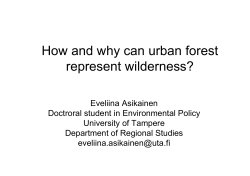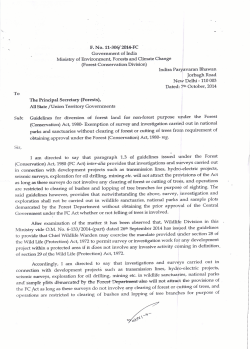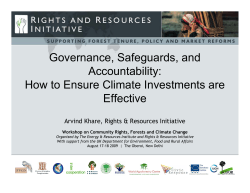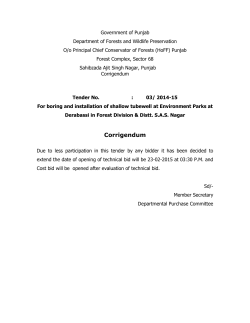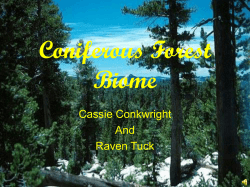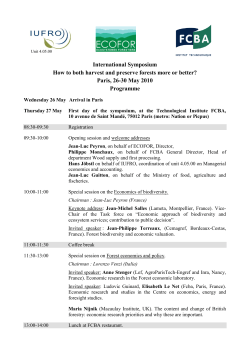
class vii-science - Kendriya Vidyalaya Gandhigram Dindigul
KENDRIYA VIDYALAYA SANGATHAN, CHENNAI REGION SUMMATIVE ASSESSMENT II - SESSION 2015 OTBA CLASS VII SUBJECT: SCIENCE Theme 2: Forests - Friends forever The forest is a complex ecosystem consisting mainly of trees that have formed a buffer for the earth to protect life forms. The trees which make up the main area of the forest create a special environment which, in turn, affects the kinds of animals and plants that can exist in the forest. The FAO (Food and Agriculture Organization) has defined forest as land with tree crown cover (or equivalent stocking level) of more than 10% and area of more than 0.5 hectare. Forests can exist from the equator to near the Polar Regions, but the character of the forest differs greatly. Based on the regional biosphere and conditions, there are three major forest biomes: Evergreen Forests An evergreen forest is a forest consisting entirely or mainly of evergreen trees that retain green foliage all year round. Evergreen forests are usually found in areas receiving more than 200 cm of rainfall and having a temperature of 15 °C to 30 °C. They occupy about seven per cent of the Earth’s surface and harbour more than half of the world’s plants and animals. They are found mostly near the equator. These forests are dense, mulch-layered and harbour many types of plants and animals. The trees in an evergreen forest have broad leaves that release excess water through transpiration. Deciduous Forest Forests where a majority of the trees lose their foliage at the end of the typical growing season are called deciduous forests. Deciduous forests are found in several parts of the world including North America, Europe, New- Zealand, Australia, and Asia. These forests go through a lot of seasonal changes are are specially adapted to withstand these environmental changes throughout the year.Trees found in a deciduous forest vary by region, but generally include species such as oak, beech,walnut, maple, chestnut and hickory. Deciduous forests grow in areas where rainfall is sufficient to support tree growth. Deciduous forests are well suited to deal with extremes in temperatures. After losing leaves in winter, the trees enter a period of dormancy until the warmer weather returns and the growing season is once again underway. Coniferous forest Coniferous forests are made up mainly of cone-bearing or coniferous trees, such as spruces, hemlocks, pines and firs. The leaves of these trees are either small and needle-like or scale-like and most stay green all year around.Coniferous forests are found mainly in the northern hemisphere, although some are found in the southern hemisphere.Coniferous trees thrive where summers are short and cool and winters long and harsh. The needle-like leaves have a waxy outer coat which prevents water loss in freezing weather and the branches are soft and flexible and usually point downwards, so that snow slides off them. The temperate coniferous rain forests sustain the highest levels of biomass in any terrestrial ecosystem and are notable for trees of massive proportions Importance of Forests Forests are key to all life forms. The richer the diversity of life, the greater the opportunity for medical discoveries, economic development and adaptive responses to such new challenges as climate change. Forests serve as a watershed. This is because almost all water ultimately comes from rivers and lakes and from forest-derived water tables. Some rivers running through forests are also kept cool and from drying out. Forests serve as a home (habitat) to millions of animals. Think of the many types of reptiles (snakes and lizards) wild animals, butterflies and insects, birds and tree-top animals as well as all those that live in the forest streams and rivers. Animals form part of the food chain in the forests. All these different animals and plants are called biodiversity, and the interaction with one another and with their physical environment is what we call ecosystem. Healthy ecosystems can better withstand and recover from a variety of disasters such as floods and wildfires. Forests are of immense economic importance to us. For example, plantation forests provide humans with timber and wood, which is exported and used in all parts of the world. They also provide tourism income to inhabitants (people living in or close to forests) when people visit to see the best of nature. Climate control and atmosphere purification is key for human existence. Trees and soils help regulate atmospheric temperatures through a process called evapotranspiration. This helps to stabilize the climate. Additionally, they enrich the atmosphere by absorbing bad gases (example CO2 and other greenhouse gases) and producing oxygen. Trees also help to remove air pollutants. Deforestation is clearing Earth's forests on a massive scale, often resulting in damage to the quality of the land. Forests still cover about 30 percent of the world’s land area, but swaths the size of Panama is lost each and every year.The world’s rain forests could completely vanish in a hundred years at the current rate of deforestation. Forests are cut down for many reasons, but most of them are related to money or to people’s need to provide for their families. The biggest driver of deforestation is agriculture. Farmers cut forests to provide more room for planting crops or grazing livestock. Often many small farmers will each clear a few acres to feed their families by cutting down trees and burning them in a process known as “slash and burn” agriculture. Forests are also cut to make room for human settlement and urbanization (these include making space for shelter, industries and roads), and to make room for mining. Logging operations, which provide the world’s wood and paper products, also cut countless trees each year. Loggers, some of them acting illegally, also build roads to access more and more remote forests—which lead to further deforestation. Forests are also cut as a result of growing urban sprawl. Not all deforestation is intentional. Some is caused by a combination of human and natural factors like wildfires, Climate Change, Pests and diseases, and subsequent overgrazing, which may prevent the growth of young trees. Effects of deforestation Looking at the importance of forests and trees in the previous pages, you can deduce the massive effects of deforestation and tree-cutting activities. Let us see a few below: Soils (and the nutrients in them) are exposed to the sun’s heat. Soil moisture is dried up, nutrients evaporate and bacteria that help break down organic matter are affected. Eventually, rain washes down the soil surfaces and erosion takes place. Soils never get their full potential back. When forests are destroyed, the atmosphere, water bodies and the water table are all affected. Trees absorb and retain water in their roots. A large part of the water that circulates in the ecosystem of rainforests remains inside the plants. Some of this moisture is transpired into the atmosphere. When this process is broken, the atmosphere and water bodies begin to dry out. The watershed potential is compromised and less water will run through the rivers. Smaller lakes and streams that take water from these larger water bodies dry up. Many wonderful species of plants and animals have been lost, and many others remain endangered. More than 80% of the world's species remain in the Tropical Rainforest. It is estimated that about 50 to 100 species of animals are being lost each day as a result of destruction of their habitats, and that is a tragedy. Plants absorb Carbon Dioxide CO2 (a greenhouse gas) from the atmosphere and uses it to produce food (carbohydrates, fats, and proteins that make up trees). In return, it gives off Oxygen. Destroying the forests mean CO2 will remain in the atmosphere and in addition, destroyed vegetation will give off more CO2 stored in them as they decompose. This will alter the climate of that region. Cool climates may get a lot hotter and hot places may get a lot cooler. What can I do to help preserve our forests? The quickest solution to deforestation would be to simply stop cutting down trees. Though deforestation rates have slowed a bit in recent years, financial realities make this unlikely to occur. A more workable solution is to carefully manage forest resources by eliminating clearcutting to make sure that forest environments remain intact. The cutting that does occur should be balanced by the planting of enough young trees to replace the older ones felled in any given forest. The number of new tree plantations is growing each year, but their total still equals a tiny fraction of the Earth’s forested land.Sometimes, we are overwhelmed by the extent of damage humans have caused, and we are not sure if an individual can make any impact. Yes you can, there are millions of people just like you, who are learning about the issue and taking little steps to help. Additionally, many governments, organizations and societies are making great strides in helping reducing deforestation, and encouraging forest plantations. But there is still a lot to do. Due to the extent and nature of forest destruction, efforts to stop deforestation and preserve them are best achieved at government and organization levels. This means that laws countries can help to enforce the preservation of forests. Laws on farming, timber and wood, as well as land use must be encouraged and enforced. Here are a few things you can also do to help. Make a conscious effort to share information with others (friends at school and family members) on deforestation and its' effects. Some of your friends may laugh at you and say it is silly to think that you can solve problems like this. But that is OK, things work better when responsible people don’t give up. Stand up for what you believe in. Join organizations, forest-preservation societies and pressure groups that aim to help preserve the rest of our natural resources. When more people work together, the impact is greater. Reduce the use of artificial items, recycle more and re-use items. Wood, paper, plastics and many other things we use every day at home can be linked to natural resources being destroyed. This means that if we all recycle more, there will be less dependence on the environment (and trees). It also means that companies and governments will import less rawmaterial from the forest regions of the world. There is a fun way to remember the most important points in forest preservation called TREES which means... • Teach others about the importance of the environment and how they can help save rainforests. • Restore damaged ecosystems by planting trees on land where forests have been cut down. • Encourage people to live in a way that doesn't hurt the environment. • Establish parks to protect rainforests and wildlife. • Support companies that operate in ways that minimize damage to the environment.
© Copyright 2025
